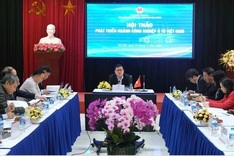Vietnam has so far attracted 3,500 foreign direct investment (FDI) projects in the garment - textile industry with a combined value of 37 billion USD, according to the Vietnam Textile and Apparel Association (VITAS).
The FDI area plays a crucial role in the industry’s growth, accounting for 65% of its total export turnover.
According to VITAS, Vietnam’s textile and garment industry is witnessing a strong surge in FDI inflows, with many large corporations pouring money into building modern factories.
The countries and territories investing big in Vietnam in this field include the Republic of Korea (RoK), China, Japan, India and Taiwan (China).
In late September, Sanbang Co., Ltd of Singapore began construction of its plant of towels, fabrics, DTY yarn at Rang Dong Textile Industry Park in the northern province of Nam Dinh with a total investment of 673.5 billion VND (nearly 30 million USD). Covering an area of 103.400 sq.m, the plant is expected to officially become operational in the fourth quarter of 2025, generating many jobs for local labourers.
Besides, several other major projects are underway, including a textile dyeing factory worth 203 million USD invested by Top Textiles Co., Ltd of Japan’s Toray Group at the park.
In February this year, the provincial authorities granted an investment license for Crystal International Group Limited Group of Hong Kong (China) to develop the Yi Da Denim Mill Co., Ltd with a total investment of nearly 1.47 trillion VND (about 60 million USD).
Meanwhile, SAB Industrial (Vietnam) Company Limited of Weixing Group inaugurated a 6-million-USD plant producing clothing accessories in the Bim Son Industry Park in the northern central province of Thanh Hoa in March.
Vietnam’s participation in free trade agreements (FTAs) such as the Comprehensive and Progressive Agreement for Trans-Pacific Partnership (CPTPP), the EU – Vietnam FTA (EVFTA), and the Regional Comprehensive Economic Partnership (RCEP), also helps the country expand export markets for textile and garment products.
According to VITAS General Secretary Truong Van Cam, thanks to international integration efforts and effective foreign investment attraction strategies, the textile industry has become attractive for foreign investors, thus helping to improve production capacity and export scale.
Experts said that Vietnam should seeks ways to promote linkage between FDI enterprises and domestic ones to further develop the textile and garment support industry.
Attention should be paid to building technical standards and regulations related environmental protection and energy saving, thus creating a solid foundation for sustainable development of the industry, they stressed.
Vietnam is the third largest textile exporter in the world, after China and Bangladesh. Positive signals in 2024 show that the industry's export turnover is likely to exceed the target of 44 billion USD this year./.
Garment - textile industry pins high hopes on FDI inflows
Vietnam has so far attracted 3,500 foreign direct investment projects in the garment - textile industry with a combined value of 37 billion USD, according to the Vietnam Textile and Apparel Association.
Source: VNA




















